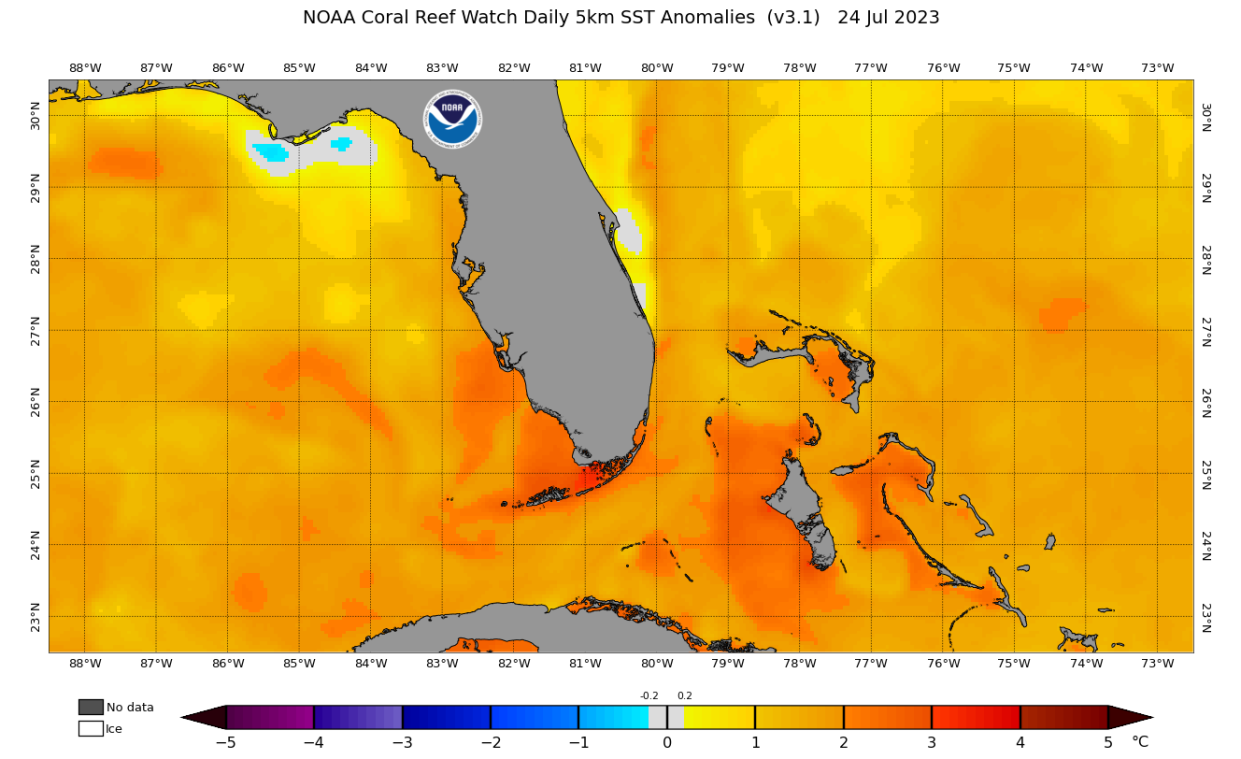101.1 degrees? Water temperatures off Florida Keys currently among hottest in the world
No hot tub needed in South Florida this week. Water temperatures in the bays between the mainland and the Florida Keys were so warm Monday that meteorologists say they were among the hottest ocean temperatures ever recorded on Earth.
Water temperature at a buoy in Manatee Bay south of Miami reached an incredible 101.1 degrees Monday evening.
That could be a new world record, besting an unofficial 99.7 degree temperature once reported in Kuwait. But meteorologists say the Florida gauge's location in dark water near land could make that difficult to determine.
Heat has been building in South Florida for weeks as the region and much of the western United States sweltered under much warmer than normal temperatures.
The heat index – what the temperature feels like – in Miami has topped 100 degrees in the city for 43 consecutive days, 11 days longer than the previous record, Brian McNoldy, a senior research associate at the Rosenstiel School of Marine, Atmospheric and Earth Science at the University of Miami, tweeted on Monday.
“Calling this heatwave unprecedented is an understatement,” McNoldy said.

What to know about that hot sea surface temperature
Was Monday’s 101.1 degree temperature in Manatee Bay a valid record measurement?
That depends on the surrounding circumstances, said Jeff Masters, a meteorologist for Yale Climate Connections. The reading would need to be verified, and no one keeps official sea surface temperature records, Masters said.
The potential, unofficial record sea surface temperature is 99.7 degrees in the middle of Kuwait Bay in the northwestern Persian Gulf, Masters said. That's according to a 2020 study by scientists with the Environmental and Life Science Research Center at the Kuwait Institute for Scientific Research.
The Manatee Bay gauge is very close to land, south of Biscayne Bay, and measures the water temperature at a depth of 5 feet.
It is possible for sunlit, shallow water surrounded by dark land and light winds to be warmer than the air temperature, Masters said. Air temperature at Marathon in the Florida Keys reached 99 degrees Fahrenheit on Monday, tying the all-time record.
Since the Manatee Bay buoy is near land, the water temperature could have been heated up by floating plants and other debris, he said. Without photos documenting clear water there Monday, “it will be difficult to verify the 101.1 degree record as valid.”
Given the gauge's location near land and the Kuwait measurement in open water, Masters said the two really shouldn't be compared.
However, he noted 11 stations near the Manatee Key reported sea surface temperatures of more than 96 degrees Monday. That includes buoys that reached 99.3 degrees and 98.4 degrees.
Federal officials say more than 40% of the world's oceans are experiencing marine heat waves, a number that could reach 50% by September.
What’s causing the heat?
While it might be tempting for some to chalk up the heat to a typically hot summer or the building El Niño in the Pacific Ocean, neither of those things can explain the heat in South Florida or in the Western U.S., scientists said this week.
"I haven't seen any strong evidence that warmer temperatures so far over the U.S. have been driven by El Niño,” said Michelle L’heureux, a climate scientist at the National Oceanographic and Atmospheric Administration.
El Niño has only recently formed a weak but complex link with the atmosphere that allows it to begin having a big influence on the world’s weather.
While an international group of scientists studying heat waves in three locations this summer say it’s possible El Niño contributed some additional heat, it wasn’t a major factor, they said.
“Weather is naturally extreme and some of the extremes we’re seeing are due to natural variability,” he said. But on top of that, there’s long-term climate change, he said.
South Florida has been suffering under a lingering high-pressure system that’s weaker with reduced trade winds, Masters said. That helps heat up water and air temperatures.
A blocked pattern seen in the jet stream over North America this summer and blamed for the heat waves has been linked to climate change by climate scientist Michael Mann and others.
Western heat waves no longer 'rare'
The unprecedented heat wave over 18 days in the western U.S. and northern Mexico this summer would have been “virtually impossible” if humans had not warmed the planet by burning fossil fuels, said the team of scientists with the World Weather Attribution, an international group studying the connection of climate change to extreme weather events.
The team, including scientists from the Netherlands and United Kingdom, found:
Such heat waves are occurring more frequently because of human activities and shouldn’t be considered rare anymore. Instead, a heat wave such as the one in the West could be expected at least once every 15 years.
A heat wave in the Western U.S. with the same likelihood would have been “significantly cooler” in a world without human-induced climate change.
The Western heat wave was more than 2 degrees Celsius warmer than it would have been without climate change.
Similar trends were seen in southern Europe and the lowlands of China, and the heat wave in China was about 50 times more likely than it would have been without fossil fuel burning, deforestation and other activities.
Unless the world rapidly stops burning fossil fuels, these events will become even more common and the world will experience even hotter and longer-lasting heat waves that could occur every 2-5 years if the world reaches 2 degrees Celsius warmer than the pre-industrial average.
“Heat is among the deadliest types of disaster,” said Julie Arrighi, a director at the Red Cross Red Crescent Climate Centre. “We need a cultural shift in the way we think about extreme heat. Extreme heat is deadly and rapidly on the rise.”
This article originally appeared on USA TODAY: Florida water temperatures climb to stunning new highs







